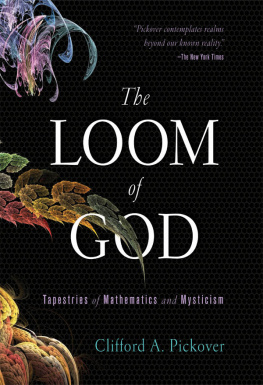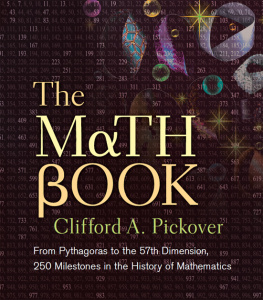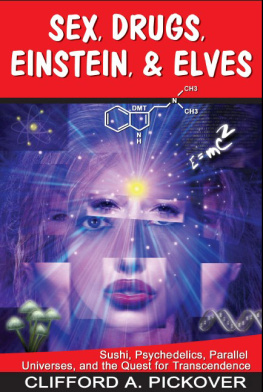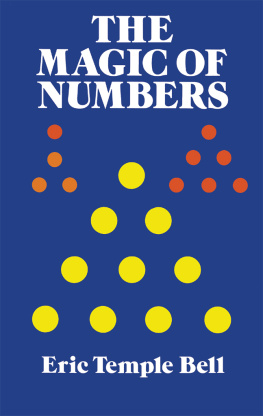

Praise for The Loom of God Pickovers lively, provocative travel guide takes readers into the fascinating realm of mystic math, from perfectly strange numbers to fractured geometries and other curious nooks and crannies of ancient worlds and modern times. Ivars Peterson, Science News Chock full of mathematical treats,The Loom of Godtakes you on a trip which explores ideas in a totally non-threatening, enjoyable format. A must for the I-hate-math person as well as the mathematical explorer. Theoni Pappas, author of The Joy of Mathematics From Pythagoras and his strange beliefs (Dont eat food that causes you to flatulate) to Goedels mathematical proof of the existence of God, Pickover guides the reader through the history of metaphysical logic. Playful and surreal,The Loom of Godis accessible to anyone whos mastered long division. Discover magazine Thought-provoking, entertaining, eerie, magical, and lively are words that describeThe Loom of God,which weaves number theory, geometry, and computer power into a beautiful tapestry of numerology, fractals, and a fantasy of our worlds future. Distinctive dazzling unconventional great for recreational enrichment reading. Mathematics Teacher Without peer as an idea machine, Cliff Pickover proves equally adept at writing.The Loom of Godis a well-crafted piece of mathematical science fiction. Charles Ashbacher, Journal of Recreational Mathematics InThe Loom of God,Cliff Pickover, in his irrepressible style, frolics through a forest of mathematical curiosities and historical tidbits, all skillfully woven into a futuristic fantasy, leaving you to wonder where he learned all that. Julien C. Sprott, Professor of Physics, University of WisconsinMadison This book mixes science and philosophy with a large dash of humor, a cupful of religion, a teaspoon of whimsy. Pickover hops from Pythagoras, the Incas, Stonehenge, Kabala, chakras, St. Augustine, and fractals with abandon. By the way, if youd like to note it in your planner, mathematics tell us the End of the World is scheduled for August 15, 2126. Be there or be square. American Reporter Praise for Clifford A. Pickover I cant imagine anybody whose mind wont be stretched by [Pickovers] books Arthur C. Clarke Bucky Fuller thought big, Arthur C. Clarke thinks big, but Cliff Pickover outdoes them both, WIRED Pickover inspires a new generation of da Vincis to build unknown flying machines and create new Mona Lisas, Christian Science Monitor Pickover has published nearly a book a year in which he stretches the limits of computers, art, and thought. Los Angeles Times In recent years, Pickover has taken up the helm once worn by Isaac Asimov as the most compelling popular explainer of cutting-edge scientific ideas. In Pittsburgh Pickover just seems to exist in more dimensions than the rest of us. Ian Stewart, Scientific American Pickover is van Leeuwenhoeks 20th century equivalent. OMNI A perpetual idea machine, Clifford Pickover is one of the most creative, original thinkers in the world today. journal of Recreational Mathematics Clifford A. Pickover is the heir apparent to Carl Sagan: no one else does better popular science writing than Pickover. Robert J. Sawyer, Nebula Award winner, author of Calculating God Add two doses of Isaac Asimov, and one dose each of Martin Gardner and Carl Sagan, and you get Clifford Pickover, one of the most entertaining and thought-provoking writers of our time. Michael Shermer, Skeptic THE LOOM OF GOD Selected Works by Clifford A. Pickover The Alien IQ Test
Archimedes to Hawking
A Beginners Guide to Immortality
Black Holes: A Travelers Guide
Calculus and Pizza
Chaos and Fractals
Chaos in Wonderland
Computers, Pattern, Chaos, and Beauty
Computers and the Imagination
Cryptorunes: Codes and Secret Writing
Dreaming the Future
Future Health
Fractal Horizons: The Future Use of Fractals
Frontiers of Scientific Visualization
The Girl Who Gave Birth to Rabbits
The Heaven Virus
Keys to Infinity
The Mathematics of Oz
Mazes for the Mind: Computers and the Unexpected
The Mbius Strip
The Paradox of God and the Science of Omniscience
A Passion for Mathematics
The Pattern Book: Fractals, Art, and Nature
The Science of Aliens
Sex, Drugs, Einstein, and Elves
Spiral Symmetry (with Istvan Hargittai)
Strange Brains and Genius
The Stars of Heaven
Surfing Through Hyperspace
Time: A Travelers Guide
Visions of the Future
Visualizing Biological Information
Wonders of Numbers
The Zen of Magic Squares, Circles, and Stars THE LOOM OF GOD Tapestries of Mathematics
and Mysticism CLIFFORD A. PICKOVER 

New York / London
www.sterlingpublishing.com STERLING and the distinctive Sterling logo are registered trademarks of
Sterling Publishing Co., Inc. Library of Congress Cataloging-in-Publication Data Available 2 4 6 8 10 9 7 5 3 1 Published in 2009 by Sterling Publishing Co., Inc.
387 Park Avenue South, New York, NY 10016
Originally published in 1997 in hardcover as The Loom of God: Mathematical Tapestries at the Edge of Time
by Plenum Trade, New York and London
1997 by Clifford A. Pickover
Distributed in Canada by Sterling Publishing
c/o Canadian Manda Group, 165 Dufferin Street
Toronto, Ontario, Canada M6K 3H6
Distributed in the United Kingdom by GMC Distribution Services
Castle Place, 166 High Street, Lewes, East Sussex, England BN7 1XU
Distributed in Australia by Capricorn Link (Australia) Pty Ltd.
P.O. Box 704, Windsor, NSW 2756, Australia Manufactured in the United States of America
All rights reserved Sterling ISBN 978-1-4027-6400-4 For information about custom editions, special sales, premium and
corporate purchases, please contact Sterling Special Sales
Department at 800-805-5489 or specialsales@sterlingpublishing.com. Acknowledgments Some people think of God busily tallying the fall of every sparrow. Othersfor example, Baruch Spinoza and Albert Einsteinconsidered God to be essentially the sum total of the physical laws which describe the universe. Carl Sagan, Brocas Brain If we wish to understand the nature of the Universe, we have an inner hidden advantage: we are ourselves little portions of the universe and so carry the answer within us. Jacques Boivin, The Single Heart Field Theory Science is not only compatible with spirituality, it is a profound source of spirituality. |
| 












